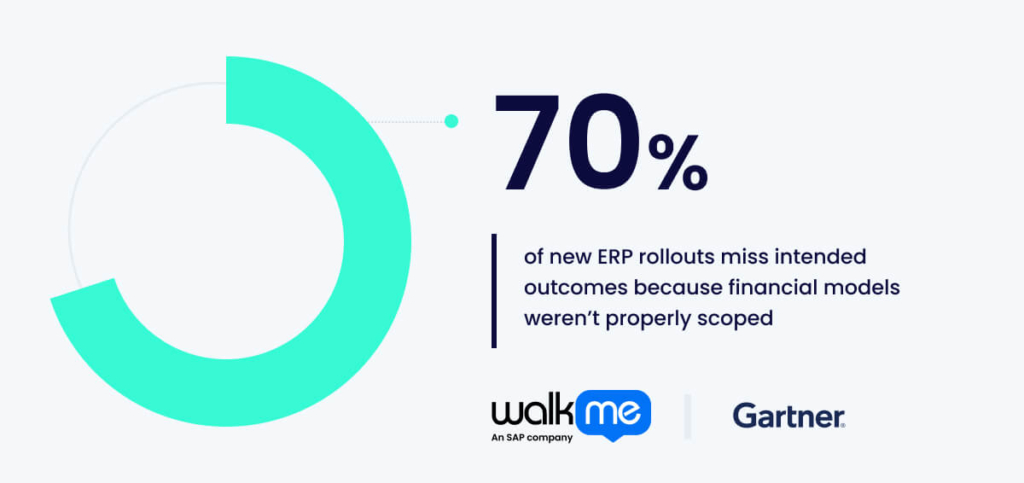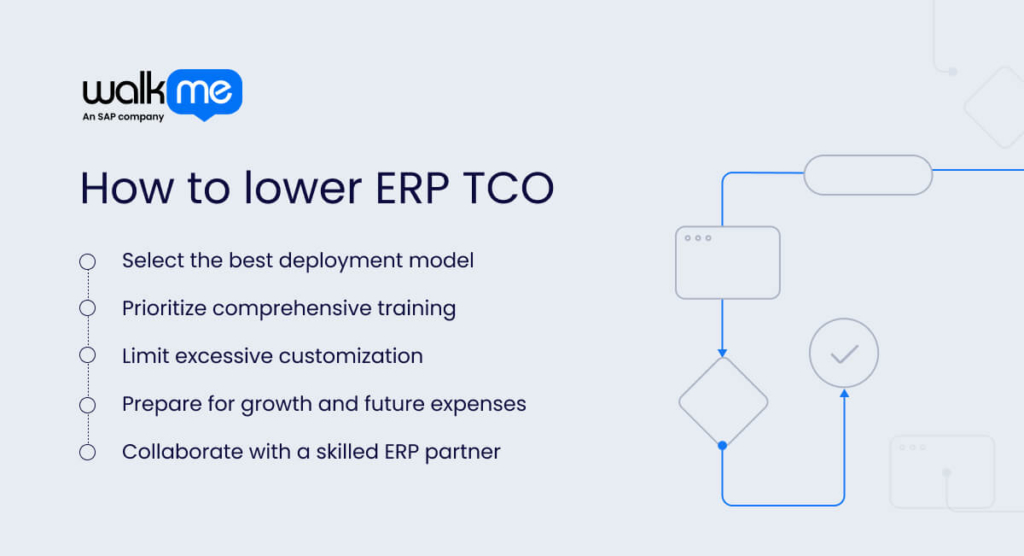Enterprise resource planning (ERP) programs unravel not because the software is wrong, but because leaders misjudge the real cost arc hidden beyond the first year.
Budget gaps tend to force reactive decisions that lower digital adoption and stall momentum. Gartner’s forecast for 2027 already hints at how common this pattern is. 70% of new ERP rollouts miss intended outcomes because financial models weren’t properly scoped.

Total cost of ownership (TCO) for ERPs forces leaders to look beyond purchase and implementation costs and consider the full financial picture, which becomes visible only when all ongoing costs are accounted for.
Understanding this early helps prevent avoidable cost shocks and keeps ERP moving at the same pace as innovation.
This article explores the total cost of ownership (TCO) of enterprise resource planning (ERP) and how all expenses combine to reveal the full financial impact.
What is ERP TCO?
ERP TCO is the complete financial picture of operating an ERP system throughout its lifecycle, measuring all costs from acquisition through full retirement.
It captures all ongoing and one-time expenses, giving a single number that represents the true cost of owning, maintaining, and operating the ERP system. This usually includes:
- Setup
- Updates
- Support
- Administrative effort
These costs interact across the system’s lifecycle, revealing how recurring updates, support, and administrative work accumulate to form the true ownership burden. Applying TCO calculations to ERP implementations reveals the continuous financial impact over a set period.
Why is ERP TCO important?
Calculating the total cost of ownership (TCO) of enterprise resource planning (ERP) systems is important and feeds into the wider picture of digital transformation.
Digital technology investments, such as ERP systems, are expensive and have lengthy implementation periods, leaving little room for error. Misjudging costs can create setbacks that are hard to recover from. That’s why TCO is essential for:
- Financial planning: Mapping projected and recurring ERP expenses against budgets ensures investments reflect long-term obligations rather than just the initial outlay.
- Measuring returns: A clear view of all costs provides a baseline for evaluating operational efficiency and whether ERPs meet performance expectations.
- Vendor selection: Understanding long-term contractual and service implications helps select solutions that maintain predictable costs.
- Managing risks: Identifying financial and operational vulnerabilities in ERPs early enables proactive mitigation before issues escalate.
What is the formula for ERP TCO?
Calculating ERP total cost of ownership (TCO) means adding up all costs associated with acquiring, implementing, operating, and eventually retiring the system.
What sets ERP TCO formulas apart from standard technology TCO is their inclusion of factors like change management and training, compliance, security, upgrades, retirement, and internal resource costs.
The ERP TCO formula
ERP TCO = Purchase cost + Implementation cost + Operational cost + Customization & Integration cost
You can include the additional factors above for a more complete view of total ownership costs. We haven’t included them in the simplified formula because they can vary widely across organizations and are harder to quantify accurately.
Example
Picture an ERP implementation scenario over five years with the following costs:
- Purchase cost: $10,000
- Implementation cost: $15,000
- Operational cost: $8,000
- Customization & Integration cost: $5,000
Applying the formula:
ERP TCO = $10,000 + $15,000 + $8,000 + $5,000 = $38,000
Over five years, the average yearly cost of the ERP is: $38,000 ÷ 5 = $7,600 per year. This calculation is a simple method for leaders to see the true financial commitment of often costly ERP solutions.
How to calculate ERP TCO
Now that you understand the formula for ERP TCO, the next step is to look at how to calculate it. The following costs represent the different categories of financial impact across the system’s lifecycle:
Purchase costs
Start by capturing all expenses required to acquire the ERP system. These costs are concrete and upfront, forming the baseline of TCO. Quantify the system license or subscription, supporting hardware, and any procurement fees. Documenting each ensures the starting point for ownership calculations is accurate, leaving no initial cost overlooked.
Implementation costs
Implementation is a process-oriented cost. Break it into stages and track labor, time, and external support per stage:
- Project planning and setup
- Data migration and cleansing
- System configuration, testing, and go-live support
This structure helps identify where the bulk of effort and therefore cost is concentrated, ensuring TCO reflects real resource allocation.
Ongoing costs
Recurring operational expenses accumulate silently over time. Use a simple table format like the following for clarity:
| Cost Type | Description | Frequency |
| System monitoring | Daily checks, alerts, and issue resolution | Monthly |
| Vendor support | SLA-based support hours and fees | Annually |
| Administrative efforts | User management, troubleshooting, and basic training | Continuous |
Customization and integration expenses
Customization and integration vary in scope and impact. Present this in scenario format:
If you automate ten workflows and integrate three legacy systems, estimate hours, resource costs, and vendor fees separately. Repeat for each new workflow or system integration. This method shows how tailored changes directly inflate TCO, highlighting trade-offs between flexibility and long-term cost.
Future upgrades and scalability costs
These costs are predictive and forward-looking. Anticipate ERP growth by modeling scenarios such as adding users, deploying new modules, or updating software versions. Estimating costs for each scenario ensures the TCO reflects current ownership and the investment needed to maintain ERP performance and capacity over time.
Calculating ERP TCO in practice
To show how ERP TCO works in the real world, let’s walk through a hypothetical five-year scenario:
1. Identify main costs
List all cost categories that contribute to total ownership:
- Purchase: ERP system and licenses
- Implementation: Setup and configuration
- Ongoing operations: Maintenance, support, administration
- Customization and integration: System adjustments and integration
- Future upgrades and scalability: Future updates and scalability
Summing the above costs gives a clear perspective of the full financial commitment across the ERP lifecycle.
2. Assign example values over five years
Using the previous ERP TCO scenario, yearly costs break down as follows:
- Year 1: Purchase $10,000 + Implementation $15,000 + Ongoing $8,000 + Customization & Integration $5,000 = $38,000
- Year 2: Ongoing $8,000 + Customization & Integration $2,000 = $10,000
- Year 3: Ongoing $8,000 + Customization & Integration $2,000 = $10,000
- Year 4: Ongoing $8,000 + Customization & Integration $2,000 = $10,000
- Year 5: Ongoing $8,000 = $8,000
3. Total the ERP TCO
- $38,000 (Year 1) + $10,000 (Year 2) + $10,000 (Year 3) + $10,000 (Year 4) + $8,000 (Year 5) = $76,000
Average annual cost: $76,000 ÷ 5 = $15,200 per year.
This single figure reflects the total financial commitment required to operate the ERP system over five years.
What factors influence the total cost of ownership of an ERP system?
The table below highlights the main factors that drive the total cost of ownership (TCO) for an ERP system:
| ERP TCO Factor | What It Includes |
| Software and subscription costs | Fees for licensing, cloud subscriptions, or modules. |
| Legacy system retirement costs | Costs to decommission and replace old systems. |
| Hardware and hosting costs | Servers, storage, and cloud infrastructure expenses. |
| Consulting and implementation fees | External expertise for setup and configuration. |
| Training expenses | Employee onboarding and ERP skill development. |
| Data migration costs | Moving and validating existing data into ERP. |
| Productivity loss costs | Downtime or reduced efficiency during rollout. |
| Testing and QA costs | System testing to ensure functionality and quality. |
| Support service fees | Ongoing vendor or internal support costs. |
| Upgrade and expansion costs | Future ERP version upgrades or module additions. |
| Ongoing maintenance costs | Bug fixes, patches, and routine system upkeep. |
How to lower ERP TCO

Reducing the total cost of ownership for an ERP system is about more than cutting the initial price. Use the methods below to keep costs under control:
Select the best deployment model
Where you host your ERP affects both setup and ongoing costs:
- Cloud: Pay-as-you-go, minimal hardware required, quick setup.
- On-premises: Big upfront investment, more control, self-maintained servers.
- Hybrid: Combines cloud flexibility with on-site control.
The key is matching the model to your team’s capabilities and growth plans. Choosing poorly can lead to hidden costs later, like extra support or expensive upgrades.
Prioritize comprehensive training
ERP systems are only as effective as the people using them. To get the most out of your tool:
- Run hands-on workshops and practice sessions
- Invest in continuous employee training
- Keep simple guides and refresher materials for everyday reference
Structured skill-building transforms user capabilities, which has a knock-on effect on system adoption and long-term performance.
Limit excessive customization
Tweaking the ERP to fit every minor process can seem appealing, but it usually adds cost:
- Focus on essential custom features
- Use built-in modules wherever possible
- Limit coding changes to make future updates easier
- Document any customizations clearly to simplify maintenance
Less customization means fewer headaches when the system grows or gets upgraded.
Prepare for growth and future expenses
ERP systems must expand as your business evolves. Preparing in advance helps avoid costly last-minute adjustments, whether adding new users, rolling out extra modules, or adapting processes and reports. Thinking ahead also ensures the system can scale, keeping operations uninterrupted and ownership costs under control.
Collaborate with a skilled ERP partner
Use the table below to understand the different types of ERP partners, their purposes, and the benefits they bring to your organization:
| ERP Partner | Purpose | Benefit |
| Implementation Consultant | Set up and configure ERP | Avoid costly mistakes and reduce delays |
| Process Specialist | Streamline workflows | Reduce hidden costs and improve efficiency |
| Strategic Advisor | Align ERP with business goals | Maximize ROI and system value |
| Support Vendor | Provide ongoing guidance | Ensure smooth growth and predictable costs |
Optimizing ERP investments through TCO insights
Using TCO knowledge to inform ERP investments is the only way ahead for forward-thinking organizations. Reviewing real-world ERP examples can demonstrate how costs play out in practice and enable better planning.
Tech sprawl, rising subscription fees, and hidden maintenance costs make it essential to plan purchases and upgrades with a full understanding of long-term financial impact.
ERP systems, in particular, carry a heavy burden in terms of reaping back financial value. Although they are an outright essential for modern business, only a small percentage of firms are running ERP TCO calculations properly.
Without a disciplined approach, businesses risk falling short on ROI, stalling digital efficiency, and undermining the very gains the system was meant to deliver over the long term.
FAQs
TCO shows the full cost of running both cloud and on-premises ERP over time. It highlights differences in setup, management, and future growth, making it easier to choose the option that fits budgets and long-term business needs.
Many organizations miss expenses like staff training, productivity dips, data migration, and small customizations. TCO brings these costs into view, giving a clear picture of the total investment needed to operate the ERP effectively.
With TCO insight, companies can plan upgrades, allocate training, and manage vendor services wisely. Understanding full ownership costs helps ensure the ERP consistently delivers value throughout its lifecycle.
Cloud, on-premises, and hybrid ERPs distribute costs differently. Cloud spreads expenses gradually; on-premises requires a big upfront investment; and hybrid sits in between. TCO captures these patterns, guiding smarter decisions for affordability and flexibility.

